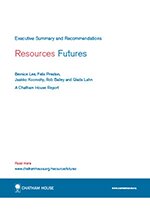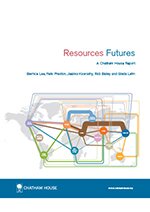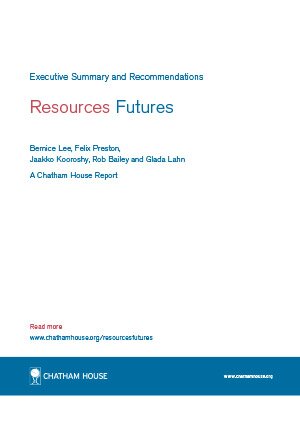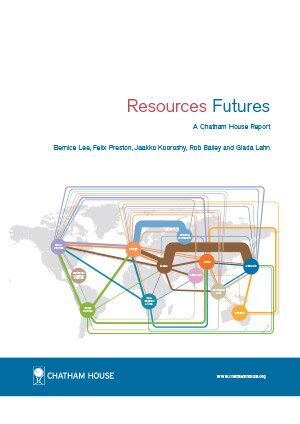Resources Futures

The New Political Economy of Resources
Resource insecurity has come back with a vengeance. The new political economy of resources is driven by the scale and speed of demand growth from emerging economies and a decade of tight commodity markets.
Whether or not resources are running out, the outlook is one of supply disruptions, volatile prices, accelerated environmental degradation and rising political tensions over resource access.
More, more and more
The emerging economies have also become major centres of resource consumption, joining existing economic powers.
Global
% share
Global cereal demand is growing gradually at 1.8% per year, while consumption of oilseeds - for animal feed, biofuels and processed foods - is soaring.
China, India and Brazil account for about 30% of global timber consumption. Worldwide, wood pellet demand increased 400% in the past decade, for use as a fuel.
Growth and changing lifestyles in the emerging economies mean that demand for meat is likely to increase by a further 20% this decade. We now consume about 17kg of fish per capita each year.
In 2006, non-OECD outstripped OECD in fossil energy demand. Since 2010, China accounted for 83% of global demand growth coal and 50% of petroleum.
New interdependencies
The value of traded resources tripled in the last decade. South-south trade in resources is now more important than traditional south-north flows.
Emerging economies like India and China are now the most important customers for oilseed exporters such as Malaysia and Indonesia (palm oil) or Brazil and Argentina (soybeans).
Strong trade links have emerged especially between South American countries (such as Brazil or Chile) and Asian countries, above all China.
Middle Eastern, Russian, and Chinese imports of meat and fish are increasingly rapidly, and developing countries are becoming increasingly important suppliers.
The balance of fossil fuel trade is shifting eastward. In particular, China and India are increasing dependence for oil on the Middle East and Africa, for gas on Russia and Central Asia and for coal Australia and South America.
Policy choices matter
The case of soybeans demonstrates the impact of policy choices on global production and consumption systems. It also shows how uneven consumption and production growth across the world is reshaping interdependencies.
China is not pursuing self-sufficiency in soybeans and imports have grown rapidly – to feed animals and build a strategic reserve. Brazil has emerged as the most important exporter. US export growth is held back by policy support for maize ethanol.
Production is concentrated
A handful of countries produce the bulk of global resources. The three largest producers for 19 commodities account for 56% of total production.
Global
% share
Just four countries account for over 70% of global maize production, while the United States, Brazil and Argentina represent 80% of global soybean output.
BRIICs countries now supply over a third of global timber. The US and EU are also major producers.
China, the European Union, Indonesia and India represent over half of total global fish production. China produces nearly 30% of global meat output.
China produces almost half of the world’s coal supply, Russia and the US account for almost 40% of gas production. Oil is more distributed with Saudi, Russia and the US producing one third.
New producers are emerging
Investment in the environmental and social resilience of these developing economies will be critical to long-term global resource security.
Average annual
growth (2000-2010)
New players can be found in Eastern Europe and South America – with Ukraine, Mexico and Brazil demonstrating strong annual growth in wheat, maize and soybean production.
Countries such as the DRC could emerge as increasingly important producers, but struggle with unsustainable forest use and illegal logging.
Nearly all of the growth in fisheries production is to be found in Asian aquaculture – with Vietnamese fish production increasing at a rate of 11% per annum.
Over the last ten years several countries showed double figure growth in production: Angola for oil, Qatar and China for gas and Mongolia, Indonesia and Vietnam for coal.
The next wave of consumers
Many of these new producers are also emerging consumers. Avoiding locking in unsustainable consumption is key.
Average annual
growth (2000-2010)
In this decade, demand for cereals and oilseeds will increase by 15-20%, driven by consumption in countries such as Indonesia, Vietnam and India.
As domestic consumption rises, many developing countries such Ghana are turning from net-exporters to net-importers of forestry products.
Shifting diets will increase demand for fish and meat in emerging economies. Average meat consumption in China increased from 3.8 to 52.4kg per capita from 1990-2002.
Low energy prices and heavy industry are driving up demand. Saudi Arabia’s oil demand has been growing by over 6%, coal demand in Indonesia and Vietnam at 9% and 12% respectively.
Short term flashpoints
Local disruptions can rapidly translate into higher international resource prices, with serious social and political consequences for countries with low resilience.
Water scarcity is a cross-cutting challenge for resource production and use. With growing populations and the impacts of climate change, competition between resource sectors and society is set to escalate.
Extreme events and natural disasters can contribute to higher prices and volatility as well as scarcities fears, as these recent examples show.
These critical shipping routes, ports, pipelines and other transport infrastructure play a key role in resources trade. A disruption here would likely be felt in international markets.
The 2007/8 food price crisis triggered protests in 61 countries, leading to riots in the locations shown.
During the 2007/8 food price crisis, nearly 30 governments applied export restrictions on crops of importance to consumers, especially rice and wheat.
Long term instabilities
The political economy of natural resources is increasingly shaped by the structural shifts in the changing natural environment; the deepening interrelationship between resource systems; and the rebalancing of global power.
Competing sovereignty claims or shared water resources do not necessarily lead to conflict, but a number of areas can be thought of as potential flashpoints.
Innovation in technologies, systems and practices can improve the availability and affordability of resources. It can also introduce new risks.
Inequalities in many of emerging producer and consumer countries are likely to become a source of political tension and investment uncertainty.
Major investments in new resource production and distribution often face significant obstacles in securing investment, strengthening infrastructure and coping with environmental change.
High prices are likely to encourage investments in environmentally sensitive and more technically challenging locations.
Download Report
Data Sources
Data Sources
More, more and more
Cereals: USDA Foreign Agricultural Service
Energy: US Energy Information Administration
Fish: FAO Fishery and Aquaculture Statistics Yearbook
Fish: FAO World Review of Fisheries and Aquaculture
Meat: World Resources Institute
Meat: OECD FAO Agricultural Outlook 2012
Oilseeds: FAO. Palmoil data refer to 2009. Soybean data include soybean oil and cake
Steel: World Steel Association
Timber: FAO ForeSTAT
Other: IFPRI (1999) 'World Food Prospects: Critical Issues for the Early Twenty-First Century'
Production is concentrated
Metals: USGS Mineral Yearbook
Energy: US Energy Information Administration
Agricultural: FAO (cereals are rice milled equivalents)
Timber: FAO ForeSTAT
Fish: FAO Fishery and Aquaculture Statistics Yearbook
New producers are emerging
Metals: USGS Mineral Yearbook
Energy: US Energy Information Administration
Agricultural: FAO (cereals are rice milled equivalents)
Timber: FAO ForeSTAT
Fish: FAO Fishery and Aquaculture Statistics Yearbook
New interdependencies
Trade: Chatham House Resource Trade Database - methodology described in Resources Futures report
Trade: UN Comtrade
Trade: BACI
The next wave of consumers
Cereals: USDA Foreign Agricultural Service
Energy: US Energy Information Administration
Fish: FAO Fishery and Aquaculture Statistics Yearbook
Fish: FAO World Review of Fisheries and Aquaculture
Meat: World Resources Institute
Meat: OECD FAO Agricultural Outlook 2012
Oilseeds: FAO. Palmoil data refer to 2009. Soybean data include soybean oil and cake
Other: IFPRI (1999) 'World Food Prospects: Critical Issues for the Early Twenty-First Century'
Steel: World Steel Association
Timber: FAO ForeSTAT
Other: FAO 'How to Feed the World in 2050'
Long term instabilities
Overall: Examples taken from Chatham House (2012) 'Resources Futures'
Renewables, China: Renewable energy in China: REN21, Renewables 2011 - Global Status Report
Water efficiency: Dobbs, R., Oppenheim, J., Thompson, F., Brinkman, M. and Zornes, M. (2011), Resource Revolution: Meeting the World’s Energy, Materials, Food and Water Needs, McKinsey Global Institutet
Irrigation India: Narayanamoorthy, A. (2007), 'Potential for drip and sprinkler irrigation in india'
Mining projects: Citigroup (2011), Sainsbury, C., Wilkins, C., Haddad, D., Seeney, D. et al., Generation Next: A Look at Future Greenfield Growth Projects.
Land investments: The Land Matrix, Beta version, International Land Coalition (ILC), April 2012
Investments, Mozambique: Martin Clark, "The Making of Mozambique", p. 2.
Investments, Yamal: Gazprom Yamal Brochure 2009 projects 75‐115 Bcm by 2015, 135‐175 Bcm by 2020, 200‐250 Bcm by 2025
Investment, Russia: Russia Analytical Digest (2008), "Russia's New Energy Frontiers", p. 10
Marginal Lands, Indonesia: Defra, UK
Fisheries, Northern Cod: Hamilton, L., et al. (2004), 'Above and Below the Water: Social/Ecological Transformation in Northwest Newfoundland'. Population and Environment, Vol. 25, No. 3, pp. 195-215.
Policy choice matters
Soybean: Chatham House Resource Trade Database - methodology described in Resources Futures report
Soybean: UN Comtrade
Soybean: BACI
Soybean: FAO
Other: Reuters (2012), 'Brazil reports continued decline in Amazon forest destruction'
Short term flashpoints
Overall: Examples taken from Chatham House (2012) 'Resources Futures'
Water, Saudi Arabia: Earth Policy Institute (2011) 'World On the Edge' p. 14.
Hydro Brazil: Leonardo Energy
Floods, Pakistan: BBC News
Droughts, Australia: BBC News
Earthquake, China: ICIS
Drought, Western Sahel: The Guardian (2010) 'Severe drought causes hunger for 10 million in west Africa'
Floods, Nigeria: Royal Dutch Shell PLC (2012), 'Nigeria oil output down 20 pct-officials'
Chokepoint, various locations: EIA (2012), 'World Oil Transit Chokepoints'
Chokepoints, various locations: Emmerson, C. and Stevens, P. (2012), Maritime Choke Points and the Global Energy System: Charting a Way Forward (London: Chatham House)
Chokepoint, Newcastle: Newcastle Port Corporation
Chokepoint, China: Xihua: 'China major ports face coal oversupply'
Qatar: Ross, B. (2012) 'The World’s Largest Aluminum Smelter Dealt 585,000 Tons of It Last Year', Gizmodo
Chokepoint, Australia: BREE
Food riots: Based on M. Lagi, K.Z. Bertrand, Y. Bar-Yam (2011), 'The Food Crises and Political Instability in North Africa and the Middle East'
Export restrictions: Table 2 in Sharma R. (2011) Food Export Restrictions: Review of the 2007-2010 Experience and Considerations for Disciplining Restrictive Measures. FAO.
Export restrictions: OECD (2010) Export Restrictions on Strategic Raw Materials and Their Impact on Trade



